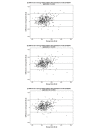EVIDENT Smartphone App, a New Method for the Dietary Record: Comparison With a Food Frequency Questionnaire
- PMID: 30735141
- PMCID: PMC6384535
- DOI: 10.2196/11463
EVIDENT Smartphone App, a New Method for the Dietary Record: Comparison With a Food Frequency Questionnaire
Abstract
Background: More alternatives are needed for recording people's normal diet in different populations, especially adults or the elderly, as part of the investigation into the effects of nutrition on health.
Objective: The aim of this study was to compare the estimated values of energy intake, macro- and micronutrient, and alcohol consumption gathered using the EVIDENT II smartphone app against the data estimated with a food frequency questionnaire (FFQ) in an adult population aged 18 to 70 years.
Methods: We included 362 individuals (mean age 52 years, SD 12; 214/362, 59.1% women) who were part of the EVIDENT II study. The participants registered their food intake using the EVIDENT app during a period of 3 months and through an FFQ. Both methods estimate the average nutritional composition, including energy intake, macro- and micronutrients, and alcohol. Through the app, the values of the first week of food recording, the first month, and the entire 3-month period were estimated. The FFQ gathers data regarding the food intake of the year before the moment of interview.
Results: The intraclass correlation for the estimation of energy intake with the FFQ and the app shows significant results, with the highest values returned when analyzing the app's data for the full 3-month period (.304, 95% CI 0.144-0.434; P<.001). For this period, the correlation coefficient for energy intake is .233 (P<.001). The highest value corresponds to alcohol consumption and the lowest to the intake of polyunsaturated fatty acids (r=.676 and r=.155; P<.001), respectively. The estimation of daily intake of energy, macronutrients, and alcohol presents higher values in the FFQ compared with the EVIDENT app data. Considering the values recorded during the 3-month period, the FFQ for energy intake estimation (Kcal) was higher than that of the app (a difference of 408.7, 95% CI 322.7-494.8; P<.001). The same is true for the other macronutrients, with the exception g/day of saturated fatty acids (.4, 95% CI -1.2 to 2.0; P=.62).
Conclusions: The EVIDENT app is significantly correlated to FFQ in the estimation of energy intake, macro- and micronutrients, and alcohol consumption. This correlation increases with longer app recording periods. The EVIDENT app can be a good alternative for recording food intake in the context of longitudinal or intervention studies.
Trial registration: ClinicalTrials.gov NCT02016014; http://clinicaltrials.gov/ct2/show/NCT02016014 (Archived by WebCite at http://www.webcitation.org/760i8EL8Q).
Keywords: diet records; energy intake; surveys and questionnaires; technology assessment, biomedical; telemedicine.
©Jose I Recio-Rodriguez, Carmela Rodriguez-Martin, Jesus Gonzalez-Sanchez, Emiliano Rodriguez-Sanchez, Carme Martin-Borras, Vicente Martínez-Vizcaino, Maria Soledad Arietaleanizbeaskoa, Olga Magdalena-Gonzalez, Carmen Fernandez-Alonso, Jose A Maderuelo-Fernandez, Manuel A Gomez-Marcos, Luis Garcia-Ortiz, EVIDENT Investigators. Originally published in JMIR Mhealth and Uhealth (http://mhealth.jmir.org), 08.02.2019.
Conflict of interest statement
Conflicts of Interest: None declared.
Figures




References
-
- Nelson M, Bingham SA. Assessment of food consumption nutrient intake. In: Margetts MB, Nelson M, editors. Design concepts in nutritional epidemiology (2nd edition) New York: Oxford University Press; 1997. pp. 123–69.
-
- Illner AK, Freisling H, Boeing H, Huybrechts I, Crispim SP, Slimani N. Review and evaluation of innovative technologies for measuring diet in nutritional epidemiology. Int J Epidemiol. 2012 Aug;41(4):1187–203. doi: 10.1093/ije/dys105. http://ije.oxfordjournals.org/cgi/pmidlookup?view=long&pmid=22933652 - DOI - PubMed
-
- Pendergast FJ, Ridgers ND, Worsley A, McNaughton SA. Evaluation of a smartphone food diary application using objectively measured energy expenditure. Int J Behav Nutr Phys Act. 2017 Dec 14;14(1):30. doi: 10.1186/s12966-017-0488-9. https://ijbnpa.biomedcentral.com/articles/10.1186/s12966-017-0488-9 - DOI - DOI - PMC - PubMed
Publication types
MeSH terms
Associated data
LinkOut - more resources
Full Text Sources
Medical

